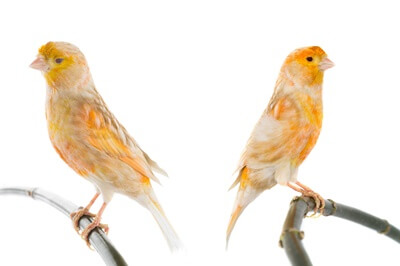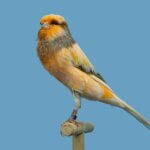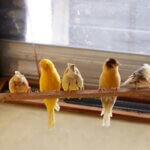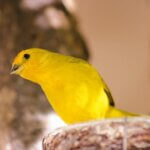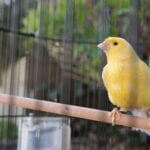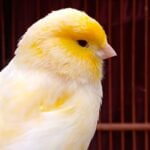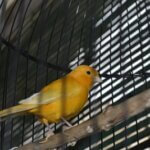Canaries require specific conditions to mate and rear chicks. Getting a canary to enter condition (a physical state conducive to breeding) isn’t easy for some owners.
There are ways to increase the chances of success and certain pairings that work better than others.
Some canaries are quick and effective breeders, such as Gloster canaries. Others can be assisted with the right temperatures, light, and dietary supplements.
Are Canaries Easy To Breed?
Breeding canaries requires more husbandry to be successful than it does with many other avian species.
You may need to change their cage, diet, provide supplements, place their breeding box carefully, and check for complications in the mother while she’s preparing to lay eggs.
Identifying the common problems and how to resolve them safeguards against issues and provides a more conducive environment for breeding, which should make your breeding pair more successful.
Canary Breeding Problems
So, you’ve paired two canaries, but they refuse to breed. If so, one of these problems is likely responsible:
1/ Not Breeding Season
New breeders often believe that canaries will mate year-round or confuse the right time to breed with the right conditions.
Canaries don’t automatically breed in the spring, even if some do in the wild. Instead, they mate based on their surrounding temperatures and the length of their light exposure.
For this reason, the canary breeding season is different from one part of the world to another, and it can also differ from the standard in the wild if you keep the birds indoors.
Canaries start to breed when the temperature is about 79 degrees Fahrenheit, which should be paired with 12-14 hours of daylight. Often, this is near the end of winter and the beginning of spring.
However, this could be summer or fall in your region, or you can provide the ideal conditions in the middle of winter when keeping canaries indoors.
If your canaries refuse to mate, it may be too hot or cold or too dark for them to enter condition.
2/ Wrong Sexing
Canaries have extremely limited sexual dimorphism. This means that females and males can appear identical, and their genitals aren’t readily apparent.
Most can only be sexed by appearance when they’re in breeding condition. Males will have an enlarged and elongated vent, while the vent of females will be smaller and flatter. However, it’s impossible to sex a canary by appearance outside of breeding season.
That means you could’ve accidentally paired two females or two males, and they’ll be unable to breed. Most of the time, pet stores or independent breeds sex their canaries with the help of a vet and attach a tag to the bird to differentiate it for sale.
Mistakes can happen, though, and some vendors skip sexing due to the expense of using a vet.
If your canaries don’t breed, you’ll need to consider their gender and whether the pair is compatible. The most effective method is a DNA test conducted by a vet, and this can cost $20 to $100 per bird, depending on your chosen clinic, the area, and the vet’s specialty.
Other methods, which are less effective but still useful, include checking the singing ability of canaries or watching for nesting and egg-laying behaviors.
For example, female canaries rarely sing. If your canary sings, it’s likely to be a male. Males often reach the peak of their singing abilities when they reach the peak of their breeding condition.
In contrast, females are the only canaries that’ll build nests or begin cleaning areas in preparation for egg-laying. If your canary begins to prepare nests, it’s a female.
3/ Wrong Lighting
Too much light can result in canaries laying eggs too early or too late in the year. Too few can make canaries believe that winter has arrived and show no interest in breeding.
Indoor lighting may seem ideal for controlling your birds’ hormones and breeding instincts. However, it’s just as easy to confuse the canaries if done improperly.
For example, providing a lamp to offer extra lighting will be beneficial during dark seasons when minimal lighting comes in through your windows.
However, if paired with regular ceiling lights, lamps, and glare from devices, the canary might get too much lighting and struggle to sleep properly. This can affect its health and ability to mate.
In contrast, the natural light from windows may be comfortable for you, but it might be too dim or inconsistent for a canary.
Females will be most affected by this, as they need to develop and lay eggs. If their hormones become unbalanced or engage too soon, it can cause breeding problems and make them sick.
4/ Parents Are Unhealthy
Canaries are notorious for failing to breed or producing deformed offspring if they’re not in peak health while reproducing.
This can include something minor, like a vitamin or mineral deficiency, or something more extreme, like an infection, lowered immune system, or exposure to stress.
Sick hens are at more risk of developing complications if they’re in poor health while developing and laying eggs. Sick canaries also do a poor job rearing their chicks, so viable offspring may be neglected or killed by their parents.
So, it’s important to offer canaries a balanced, varied diet in the weeks leading up to breeding season. This will include vegetables, fruits, grains, and formulated pellets. Females, in particular, need to have calcium supplements so that they can form strong eggshells.
If your canaries won’t breed, offer them supplements and vary their diet. You may need to skip this breeding season to get them in full health and try again next time when they’re prepared.
5/ Not Enough Food
Breeding canaries will eat more, be more active, burn more nutrients, and sacrifice more food for their young when they arrive.
Specifically, breeding canaries need to eat 25% of their body weight daily, while non-breeding canaries need 10% daily. This is true before egg-laying and after it.
This can prevent successful mating if your canaries are fed the same during breeding season as during all other parts of the year.
You should provide additional food or free-feeding, so they can eat as much as they’d like. Unless your canary already has an eating problem, with a tendency to over-feed, this shouldn’t be a problem.
5/ Aggressive Males
Breeding may be unsuccessful if the pair don’t get along properly. Personality clashes sometimes make it so that both canaries don’t like each other. If they refuse to bond, then they can’t mate with each other.
Alternatively, the male could be feeling aggressive and fighting with his companion. This could be motivated by a lack of food, stressful surroundings, or a hormone imbalance in the male.
Placing the mating pair too close to another cage of birds will also make it territorial, and it may take out its negative feelings on its partner.
No matter the case, if your canaries behave aggressively, you should separate them. This is true if both are aggressive, or the male or female is the perpetrator. Even if the two manage to breed, they’re likely to harm the eggs or chicks.
You may need to separate them until you can determine the cause of their anger. You may have a badly matched pair if no motivation can be found.
It could be that both require a new mate or the non-aggressive mate at the least.
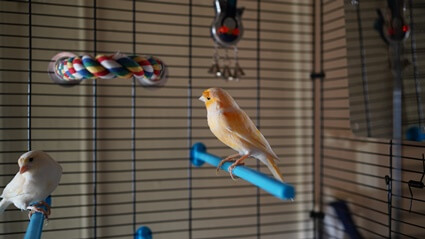
6/ Infertile Eggs
Just because a canary lays eggs doesn’t mean they’ll hatch. If this happens, here’s why:
- The Female didn’t breed with the male, but optimal conditions led to her laying unfertile eggs.
- Eggs were poorly cared for, perhaps by experienced, ill, or aggressive parents.
- The male and female attempted to breed but lacked experience.
- The Female had mineral and vitamin deficiencies, which affected her eggs’ viability.
Solving these issues should make the next batch successful. In some cases, females can lay some infertile eggs among a clutch of fertile eggs. These infertile eggs should be removed after you have candled them.
To check if canary eggs are fertile, hold up the egg to a bright light to see if there is an embryo. Fertile eggs will have visible blood vessels. Return fertile eggs into the nest within 10 minutes.
Conditioning Canaries for Breeding
Conditioning refers to putting canaries in an environment where they’re encouraged to breed. Canaries can still breed without your interference, but this is hard to predict and control.
Canaries need light, temperature, and nutrition to breed. To better control the breeding condition, you will need to adjust the following:
Light
Canaries naturally reach their breeding condition after 12-14 hours of UV light.
If you can’t provide this naturally due to your home’s placement or the region you live in, it can be replicated artificially by doing the following:
- Cover your canary’s cage when the sun sets, and remove the cover during sunrise.
- Use smart lights that automatically turn on and off based on your settings
- Increase exposure to UV lamps by 30 minutes every week until the canary’s daylight hours reach about 12 per day. Do this over 1 month.
Temperature
Since most are placed at room temperature, this isn’t a problem. However, depending on your home, you may need to isolate the canaries in a room that’s 70 degrees Fahrenheit.
Some breeding pairs will be comfortable in the 65-85 degrees range, but it can make things difficult.
Diet
You should change your canaries’ diet at least 3 weeks before breeding.
If it doesn’t already, it should include a balanced range of nutrients and supplements, and these will ensure fewer complications when gravid and during rearing.
Calcium
Canaries need additional calcium for several weeks before mating. According to Ibis, calcium supplementation can prevent egg binding and deformed chicks. Good sources of calcium include:
- Cuttlebone
- Dandelion greens
- Bok choy
- Kale
- Apricots
- Kiwi
- Oranges
- Strawberries
Protein
Protein should be soft and easy to digest, so avoid chicken, beef, fish, and other dense protein sources. Breeders often used chicken eggs as the main source of protein, but others can include:
- Protein cereal
- Wheatgerm
- Powdered eggs
- Soaked seeds
Vegetables
Vegetables are an excellent way for your canaries to gain the vitamins and minerals they need for reproducing. Make sure to pick vegetables that are rich in vitamins D and E. Good options include:
- Lettuce
- Spinach
- Kale
- Green beans
- Peppers
- Broccoli
- Cabbage
- Cauliflower
- Sweetcorn
- Sweet potato
Vitamin Supplements
Breeders recommend vitamin E supplements 3 weeks before the breeding season. According to Approaches in Poultry Dairy & Veterinary Sciences, vitamin E deficiency reduces fertility rates. As such, vitamin E is necessary for:
- Producing eggs
- Increasing conception rate
- Keeping sperm more motile
- Ensuring eggs hatch
- Making chicks healthy
Other supplements should include vitamin D and amino acids. These vitamins and nutrients are hard to source from food but can be offered in powdered form atop other foods.
You should stop using supplements once the female lays her first egg, as continuing afterward may lead to hypervitaminosis.
Picking The Right Cage
A breeding pair should have a separate cage. The enclosure should not face other birds, as this can lead to defensive and territorial disputes.
A cage should be placed in a well-lit area. Ideally, the birds will see out a window to check the time of day. Don’t place the entire cage in direct sunlight because this can lead to overheating. Allow some parts to be in the shade.
Place the cage in a quiet area without a lot of foot traffic. Too much commotion will prevent the canaries from mating, laying eggs, or feeding their young.
In particular, you can get a breeding cage with a divider in the middle. The divider is made up of a solid partition and a wire partition.
Once the female starts building a nest, remove the solid partition. Once the pair begins kissing (regurgitating food) through the wire, you can remove the wire partition.
Males usually feed the mother and help feed the chicks. If you don’t have a breeding cage, you can use two cages placed side by side instead.
Canary Breeding Tips
Here are some tips and advice to remember when breeding canaries:
Record Health
If you’re a new breeder, maintain a record of your canaries’ health. If your canary grows sick, records will enable your vet to determine the cause of the problem.
Document Breeding
Record whether eggs are fertile or infertile once they’re laid and hatched. Document the birds’ genetics and lineage if you’re breeding show canaries or canaries to sell.
Signs of Breeding Condition
Positive signs can help you determine when breeding condition has been achieved.
For males, this includes singing louder and more often, dropping wings, producing shinier feathers, and dancing around the female.
In females, the vent becomes enlarged, she calls for a mate, and starts nest building.
Hand-Feeding
Some new mother canaries won’t know how to feed their chicks.
If this happens, you’ll need to hand-feed them. You can reach out to a breeder, a rescue facility, or a friend who has hand-reared chicks to learn.

